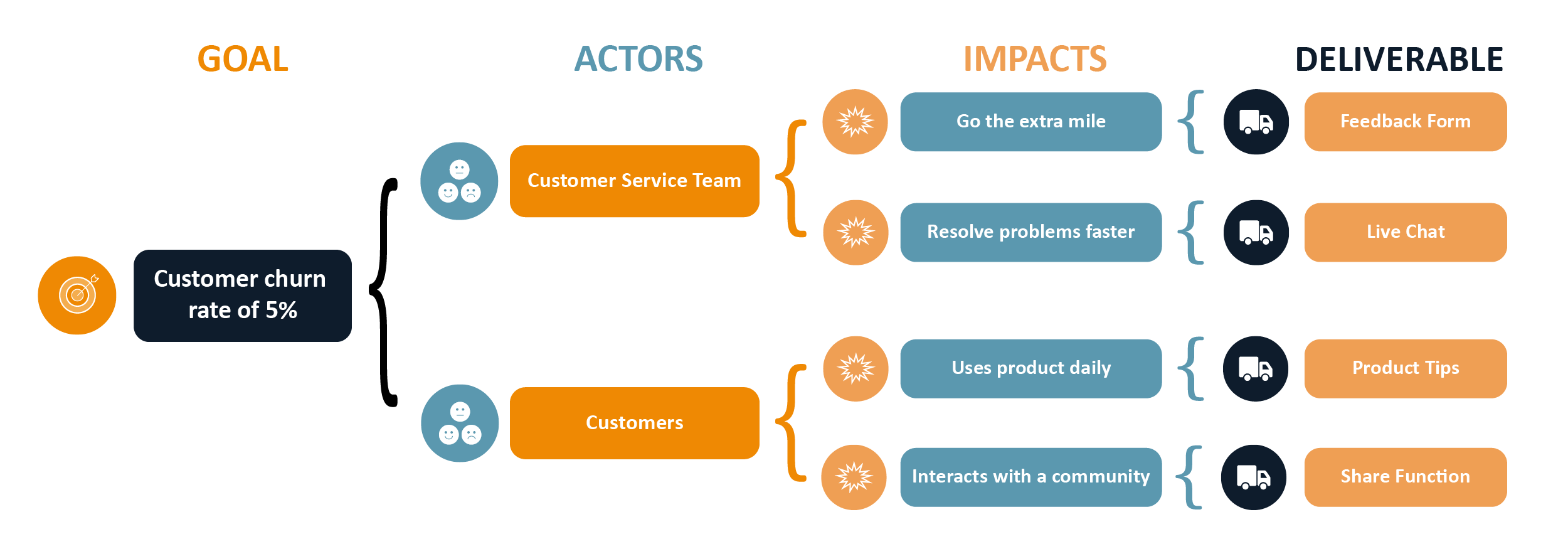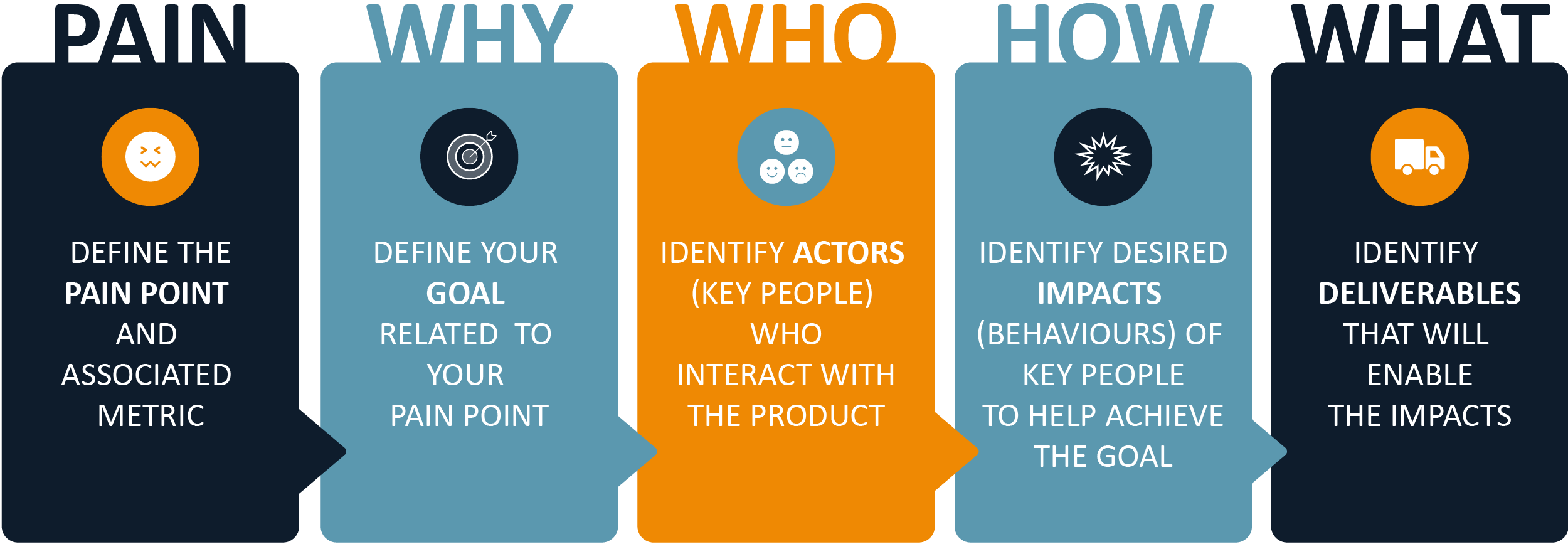As a product manager, I’m always searching for ways to deliver more value to customers. One of the best approaches I’ve used recently is impact mapping.
Impact maps depict the link between a business goal, stakeholders and their behaviour, and the deliverables that we can produce to help us achieve that goal.
Impact Mapping Process
In this blog I’ll provide an overview of impact mapping and share a step by step approach to creating one:
1. Define the Pain Point
A pain point can be identified using customer feedback (e.g. NPS), customer / market research or business analytics.
The pain point may be that our churn rate for a software product is 20% for subscription customers. We want to reduce this percentage to improve revenue.
2. Define the Goal
The goal should relate to the pain point’s metric so that we can track the effectiveness of our actions – e.g. we will reduce churn to 5%.
Goal: Customer churn rate of 5%.
3. Identify the actors
An actor is any person or group that interacts with the product. Actors may be blockers who seek to stop us from reaching our goal, or individuals whose behaviour has a positive impact.
We can influence our actors’ behaviour to help us to reach our goal. To maximise effectiveness, we’ll focus on the actors who have the most influence (key actors).
In the churn example above, key actors would include the customer service team and the customer. The customer interacts with the customer service team when they’re experiencing product or service difficulties or seeking to end their subscription – so we can use this interaction as an opportunity to improve our customer experience and ensure customers stay subscribed.
Actors: Customer service team, customers.
4. Identify the impacts
Now that we’ve identified key actors we can explore impacts (actor behaviours) that will help us to achieve our goal. (If a person’s behaviour is a risk to achieving our goal, we can list minimising the effects of this negative behaviour as a desired impact.)
Customer service team impacts
Let’s assume that a customer is more likely to stay subscribed if the customer service team goes the extra mile to fix their problem when they are unhappy. We’ll define “going the extra mile” as contacting the customer directly and helping them achieve what they need to with the product. Similarly, the speed at which problems are resolved could influence subscription – i.e. customers are more likely to stay subscribed if the customer service team is responsive.
Customer impacts
For the customer, let’s hypothesise that if they feel a sense of community while using the product and are genuinely engaged, they are more likely to stay subscribed.
Customer service team impacts:
- Go the extra mile to fix the problem if customer is unhappy
- Resolve customer problems faster
Customer impacts:
- Is engaged with the product (uses it at least once a day)
- Interacts with a community while using the product
5. Identify the deliverables
Now we must identify and design features to enable the impacts to achieve our goal. By identifying at least one deliverable per impact, we will have a list of tasks we can begin to action.
Customer service team deliverables
Live online chat will help the customer service team to resolve product-related problems faster, thereby enabling this impact. Similarly, a feedback form can capture customer feedback, helping the team to understand if the customer is unhappy with the product and allowing them to proactively contact them.
Customer deliverables
We might send emails with product tips and monitor email open rates as a starting point to improve customer engagement. We could also provide a function that allows customers to share content with other users, as a way to encourage them to use the product with a wider community.
Customer service team deliverables:
- Go the extra mile to fix the problem if customer is unhappy
- Introduce form to allow customers to send product feedback
- Resolve customer problems faster
- Live chat to allow instant communication
Customer deliverables:
- Is engaged with the product
- Send customer usage tips and questions about product experience
- Interacts with a community while using the product
- Function for people to share their content
6. Creating your impact map
Deliverables are now clearly outlined and can be mapped.

You can use impact mapping to develop user stories or epics for delivery:
As an [Actor], I want [Deliverable], so I can [Make Impact]
For example:
As a customer service representative, I want live online chat, so I can resolve customer problems faster
You impact map needs to be tested and validated
It’s also worth noting that, all the deliverables identified are assumptions – their ability to deliver against the goal needs to be tested.
Testing will validate or invalidate the assumptions we have made about the effectiveness of these deliverables in achieving our goal. If found to be ineffective, the product manager can iterate over the impact mapping process with new understanding.Impact mapping is a powerful technique for developing a set of actionable deliverables to drive business goals.
It can also be a useful tool to improve understanding of the team context via its process of mapping multiple actors in reference to a single goal. And user stories can be used to show the value of a deliverable in working towards a goal.
Download a printout of the steps covered in this blog.



